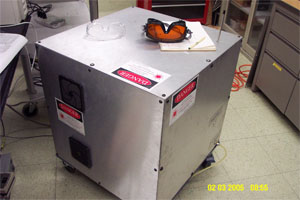Aerosol Plasma Technology for Airborne Particle Measurement
Detection of Airborne Particles of Unique Signature
Natural and man-made airborne particles are effective carriers for transporting a variety of materials in the atmosphere. The wide range of particle size (1 nm to 100 µm), complex morphology, density, refractive index, mixed chemical properties and biological availability, for example, together make them extremely difficult to interrogate with a single instrument. The size-resolved composition holds a key to obtain unique fingerprints for identifying sources in various environmental, pharmaceutical, forensic, and defense applications.
Technical Concept
The major challenge of detecting airborne particles in near real-time is the capture of dilute non-homogeneous dispersion of the materials in the air. By employing a shaped focusing nozzle as a particle concentrator, one can effectively increase the number of particles to be detected and enhance the formation of microplasma induced by a pulsed laser. Lately, successful design and implementation of an electrical enhancement on the laser plasma by the research group at ORNL has significantly enabled the detection sensitivity making the technique suitable for a wide range of aerosol composition measurement. The electrically-enhanced laser plasma contains chemical fingerprints of the particles that can be used in applications such as source identification and apportionment, worker safety protection, and so on. Near real-time (on the order of a few minutes) detection of the fingerprints can then be performed by using the time-resolved plasma emission spectroscopy. The advances in microelectronics and digital signal processing also facilitate the construction of a compact rugged system. The novel aerosol spectroscopic technique is simple to implement, requires no sample preparation, and generates no analytical waste. The technique was awarded a US patent (# 6,359,687) in June 2002.Current System Abilities
- A field-portable system (above figure) has been developed and tested in a number of campaigns.
- The second-generation system has power requirements of 110VAC, 50/60Hz, 15A, and single phase. Power, signal conditioning, and cooling systems are contained in the unit. A laptop computer with a docking station runs the whole system including data processing.
- The unit shown in the above configuration can be transported and operated by a single person. The main module (the enclosed section) has a footprint of 24” (L) x 24” (W) x 24” (H). The system is shown mounted on a wheeled platform to facilitate transportation.
- Many elements in various chemical forms (inorganic salts, metal-organo compounds, and metal oxides) have been examined by the technique. These elements include light and heavy metals, and non-metal elements (e.g., carbon, sulfur, phosphor, chlorine, and fluorine). The detection limits range from ng/m3 to µg/m3 depending on elements and to a lesser extent on the chemical forms.
For more information, contact:
Meng-Dawn Cheng (chengmd@ornl.gov, 865-241-5918)


